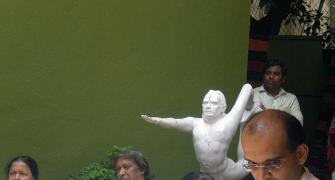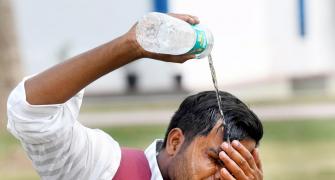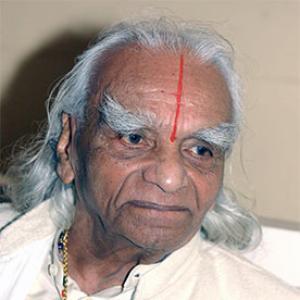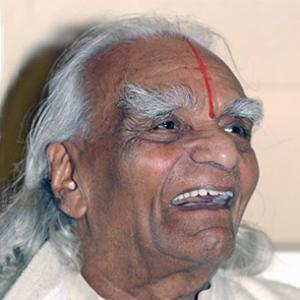 Two of the greatest modern exponents of yoga began their life in Mysore, under the tutelage of the legendary Krishnamacharya. For both of them, life was yoga. And yoga was life, says Sunaad Raghuram.
Two of the greatest modern exponents of yoga began their life in Mysore, under the tutelage of the legendary Krishnamacharya. For both of them, life was yoga. And yoga was life, says Sunaad Raghuram.
The royal patronage of the legendary Wodeyar dynasty evolved the city of Mysore into one of exquisite character. It is a city where the clock ticks ever so slowly, putting on show, on the dial of life, the kaleidoscopic images of royal personages who walked the city's soil for long years in glorious splendour; the broad tree-lined, bougainvillea-smothered boulevards and the grandeur-filled edifices that dot the city, a testimony to their scope and vision.
It is a city where the air is still heavy with the dignified aura of royalty when, in the years long past, the Maharaja presided over myriad esoteric pursuits ranging from the fine arts to wrestling; a place like none other, where the rich ambrosia of heady culture permeated the very existence of its people.
The Mysorean is a gentle, soft-spoken, easy-going kind of man for whom the din and tumult of a Bangalore or Mumbai is anathema; a kind of culture shock which leaves him dumbfounded. Not for him the mindlessness of heavy traffic, not for him the frenzied pace of business.
Not for him the rush hours of life where clambering on to a bus or a train defines the difference between success and failure. To the Mysorean, life was almost always meant to be an unhurried, relaxed, quiet and elaborate repast. And even to this day, it is largely so.
Not too far from the wondrous palace of the Wodeyars, with its shining red domes, in the middle of the old part of Mysore, is the Sita Vilas road. Narrow, with mostly ancient houses on either side, wedged closely together, this road has etched itself on the city's subconscious.
Along this very road is the Parakala Matha, next to the famous Jagan Mohan art gallery; an ancient repository of the Srivaishnava faith, a temple and hermitage, from where evolved two of the greatest known gurus of yoga -- Bellur Krishnamachar Sundararaja Iyengar and Pattabhi Jois.
It was in the 1930s that these two young boys, Iyengar born in Bellur in the district of Kolar near Bangalore, and Pattabhi Jois, born in the little village of Kowshika in the district of Hassan, came under the tutelage of Krishnamacharya, a renowned yoga guru and Sanskrit scholar who taught yoga in Mysore thanks to the munificence of the royal court.
Like all of us, Pattabhi Jois and Iyengar too played host to age. But age, in their case, seemed to be a casual cousin who just dropped by. Not a long staying relative. Who bears upon you the burden of his visit's upkeep.
They were more like sun kissed flowers. Vibrant, colourful, joyous and bright. Age alighted upon them like a bee and buzzed off in an instant.
 Pattabhi Jois had seen 94 summers when he passed away in 2009. Or winters, if you like. And Iyengar, 96, when he breathed his last on Tuesday, August 19, 2014.
Pattabhi Jois had seen 94 summers when he passed away in 2009. Or winters, if you like. And Iyengar, 96, when he breathed his last on Tuesday, August 19, 2014.
In both of them, the eyes flashed bright hues. The smile was friendly and fulsome. It didn't matter that it was denture assisted. The skin was taut and blemishless. So much like their resolve to do what they did in stages almost every waking moment, for some 77 of their 90-odd years. Learning, lecturing and teaching yoga. Theirs was a journey. Long, timeless, poignant, exciting, frustrating, fulfilling and in a sense, eternal.
Two of the greatest living gurus of yoga in the world, Jois lived in Gokulam, Mysore. And Iyengar in Pune. If they were not teaching in London or Paris or Melbourne or New York or San Francisco, that is.
Theirs was the life of men whose soul had been satiated by the sheer attainment of life's ambition; the fulfilling of a karmic yearning; the continuing of a tradition that was steeped in their very being.
To both of them, life was yoga. And yoga was life. There was nothing beyond it. Not anything that they had tried seeking. Pattabhi Jois ran away from his home as a 14-year-old boy. Getting into the train to Mysore from the station at Ambuga, a neighbouring village, four miles away, because he didn't want anyone to notice him or even recognise him.
For Pattabhi Jois, the mind had been made up. To answer some strange otherworldly calling. Watching guru Krishnamacharya demonstrate yoga at the Jubilee Hall in Hassan one 1928 evening, stirring in him some irresistible awakening. 'It's the shaping of the soul over many lives,' he once said. His answer to why he got so irrevocably drawn to the pursuit of yoga.
Long years of tapas. At the Sanskrit College in Mysore. In the early days, the meals were frugal, but the insults to the heart were substantial. Poverty snapped at his heels like a persistent dog. He could only glare back and keep going. His resolve was cast in solid iron and his mind wavered only as much as a mountain would against a mild breezy waft.
The numbing sacrifices in life. The honing of his very internal rhythms to suit the lifestyle of a yogi. From an unearthly young age. Waking up at 4 in the morning. When the rest of the world remained snugly curled up in the folds of a hazy dream. Pushing his limbs to do the mind's bidding. Yoga practice. And more of it until the sun was high up in the sky. Day after day. Week after week. Years went by.
B K S Iyengar tread more or less the same path. Incidentally, under the very same guru Krishnamacharya, who was also his brother-in-law, married to his sister.
A sad childhood marked by his father's untimely demise, an Influenza afflicted mother and a battle with tuberculosis; yoga eventually curing him of a potentially life-threatening disease.
.jpg?w=670&h=900) There was to both of them the visage of a yogi. The mellow glow of knowledge and achievement. But not even a hint of the ego. Quite surrealistically humble. Jois didn't speak the English language beyond the customary 'Hello' and 'Thank you.'
There was to both of them the visage of a yogi. The mellow glow of knowledge and achievement. But not even a hint of the ego. Quite surrealistically humble. Jois didn't speak the English language beyond the customary 'Hello' and 'Thank you.'
But yet there was an unbelievable communion happening all the time between him and his tens of hundreds of Western students. They called him Guruji. And in return they got a soulful of benediction. Or so it seemed going by the way they fawned over his presence.
Pattabhi Jois walked the long cavernous halls of airports in the West amidst the gloss, the glitter, the lights and the shrill crescendo of revved up jet engines taxiing for take-off. But he was always his own self. In his white dhoti and shirt and pump shoes.
He neither understood the thousand reasons his co-passengers had to be on the same plane nor did he want to know why else the world moves. To him he was on his way to Los Angeles or Encinitas or Hawaii because a student had invited him to be there.
Iyengar, on the other hand, had honed the English language to such perfection that he could lecture on yoga and give demonstrations to his students using the power of the language. This gave him a kind of head start over his equally accomplished contemporary, Pattabhi Jois.
Iyengar became the first yoga guru to take the largely mysterious and esoteric power of yoga to the West. And make a telling impact. On an audience that was mesmerised and stupefied by the various possibilities it offered, not only in its intrinsic worth as a remedy for various physical ailments but also equally as a panacea for the tumultuousness of the mind.
While Pattabhi Jois, steeped as he was in the ancient traditions of yogic philosophy, continued to teach yoga in its most original form, Iyengar improvised on it. Improvisations did not mean that he took the sheen off the original method except that he made the practice of yoga far more 'student friendly.'
The use of props like ropes, belts and blocks came into being in his class. The bending, the stretching, the twisting and the turning became far easier to a whole lot of students who either had issues with flexibility or were plain scared to try body contorting postures they were not used to.
Pattabhi Jois, on the other hand, who was a master of Sanskrit, knew the philosophy of yoga like none other. The scriptural references to the concept of yoga, the metaphysical avenues it opened up to its practitioners and the connection between the body and soul was all encompassing in his approach.
Jois was the quintessential guru while Iyengar was a guru who gave it a tiny rock and roll tweak, as it were! Both the methods had their followers from the West, but the Iyengar method naturally found a far greater audience due to its comparative simplicity of practice. So much so that a medical prescription in the United States once simply said 'practice Iyengar yoga' written on it by a doctor as a remedy for some ailment that a patient had complained about!
Undoubtedly, it was B K S Iyengar who made yoga popular in the midst of the hubbub, the noise, the clatter, the rush and rhapsody of the west. New York City for example, began to host the 'Om'! Soothing, soulful, calm and clear. A balm to the mind, a song to the soul, a pursuit of the infinite.
The New Yorker began waking up at 5 in the morning. It didn't matter that the temperature outside was 27 degrees. Fahrenheit! Marichasana on Madison Avenue! Trikonasana on 34th Street! There aren';t many New York streets, by the way, where you don't find a sign that says 'Yoga'.
 An eclectic bunch of men and women who lead lives so different from the rest of New York. No Dunkin' Donuts for them. So what if the ad says America runs on it. Not them for sure. Only the traditional nuts and fruits, not to forget lentils and cilantro will do. Coconut water instead of Carlsberg beer!
An eclectic bunch of men and women who lead lives so different from the rest of New York. No Dunkin' Donuts for them. So what if the ad says America runs on it. Not them for sure. Only the traditional nuts and fruits, not to forget lentils and cilantro will do. Coconut water instead of Carlsberg beer!
The pursuit of Adhyatma (the self) through many accents!
A display of amazing self-control in their lives for sure. Otherwise, they wouldn't be able to do the same when they practiced the many asanas definitely. A love of a concept, a method of living, a manner of being. Yoga that is practised much more sincerely and studiously for sure, than in any part of the country of its birth itself- India.
Frequent visits to India to learn from the great masters themselves. To Pune and Mysore. Their students knew as much about Gokulam and Lakshmipuram; Nalpak hotel and the Lakshmi Janardhana Iyengar's bakery in Saraswathipuram in Mysore or the Senapati Bapat road or Camp area in Pune as Broadway and Times Square; Central Park and the Chrysler building!
Where for a whole lot of them, the day began with Surya Namaskar. With a faint sun peeping out from between the 56th and the 69th floors of two behemoths on Fifth Avenue while for most others, it was with Subway sandwiches with cold cuts and mayonnaise or bagels and coffee at Starbucks!
All because two young boys began to wake up at 4 in the morning in a little town called Mysore in India, 12,000 miles across the Atlantic some 80 years ago. To learn yoga!
Images, top 3: In 2005, the two legends came face to face for the first time in 65 years since learning yoga together under Krishnamacharya in Mysore.
Image, bottom: Sharath Jois, Pattabhi Jois's grandson. The Mysore yoga legacy continues.









